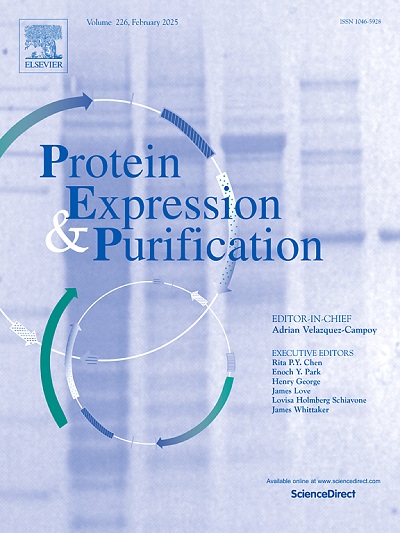Bioinformatics analysis and polyclonal antibody preparation of Mesocricetus auratus DHX30
IF 1.2
4区 生物学
Q4 BIOCHEMICAL RESEARCH METHODS
引用次数: 0
Abstract
DHX30, as members of the DExD/H family, plays a crucial regulatory role in RNA metabolism and antiviral innate immune response. To facilitate comprehensive investigation of DHX30's multifunctional involvement in viral life cycles, a highly specific anti-DHX30 antibody is needed. In this paper, we used bioinformatic analyses combined with the Immune Epitope Database (IEDB) to identify immunodominant B-cell epitopes in the Mesocricetus auratus DHX30 protein. A hydrophilic peptide sequence demonstrating strong antigenic potential was selected for recombinant antigen production. The corresponding DHX30 truncated gene fragment was cloned into the pET-28a vector to generate the pET-28a-DHX30-N expression construct. Following transformation into E. coli BL21(DE3) competent cells, recombinant protein expression was induced and subsequently purified via Ni-NTA affinity chromatography. Six-week-old female KM mice were immunized intraperitoneally with the purified antigen. The antibody titer was determined by indirect ELISA, demonstrating high serum titers. Specificity validation through immunoblotting and immunocytochemical analyses confirmed the antibody's exceptional target recognition capability. These antibodies are expected to develop detection methods for further research.
auratus中囊绦虫DHX30生物信息学分析及多克隆抗体制备。
DHX30作为DExD/H家族成员,在RNA代谢和抗病毒先天免疫应答中起着至关重要的调节作用。为了全面研究DHX30在病毒生命周期中的多功能参与,需要一种高特异性的抗DHX30抗体。本文采用生物信息学方法结合免疫表位数据库(Immune Epitope Database, IEDB)对auratus Mesocricetus DHX30蛋白的免疫显性b细胞表位进行了鉴定。选择了具有强抗原潜力的亲水性肽序列用于重组抗原的生产。将相应的DHX30截断的基因片段克隆到pET-28a载体中,生成pET-28a-DHX30- n表达构建体。转化大肠杆菌BL21(DE3)感受态细胞后,诱导表达重组蛋白,随后通过Ni-NTA亲和层析纯化重组蛋白。用纯化后的抗原腹腔免疫6周龄雌性KM小鼠。间接ELISA法测定抗体滴度,血清滴度较高。特异性验证通过免疫印迹和免疫细胞化学分析证实了抗体的特殊目标识别能力。这些抗体有望开发出进一步研究的检测方法。
本文章由计算机程序翻译,如有差异,请以英文原文为准。
求助全文
约1分钟内获得全文
求助全文
来源期刊

Protein expression and purification
生物-生化研究方法
CiteScore
3.70
自引率
6.20%
发文量
120
审稿时长
32 days
期刊介绍:
Protein Expression and Purification is an international journal providing a forum for the dissemination of new information on protein expression, extraction, purification, characterization, and/or applications using conventional biochemical and/or modern molecular biological approaches and methods, which are of broad interest to the field. The journal does not typically publish repetitive examples of protein expression and purification involving standard, well-established, methods. However, exceptions might include studies on important and/or difficult to express and/or purify proteins and/or studies that include extensive protein characterization, which provide new, previously unpublished information.
 求助内容:
求助内容: 应助结果提醒方式:
应助结果提醒方式:


